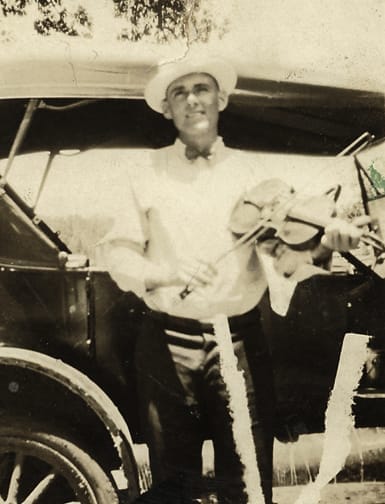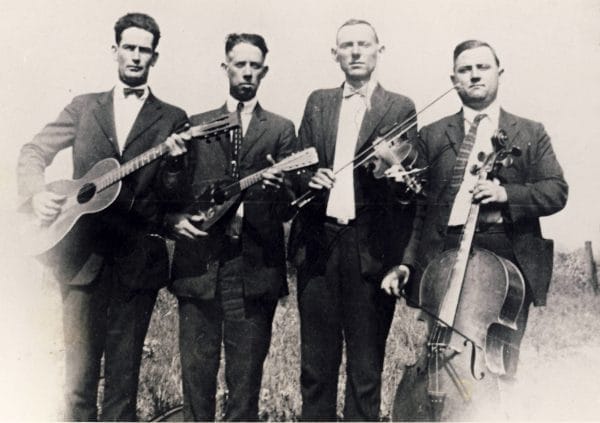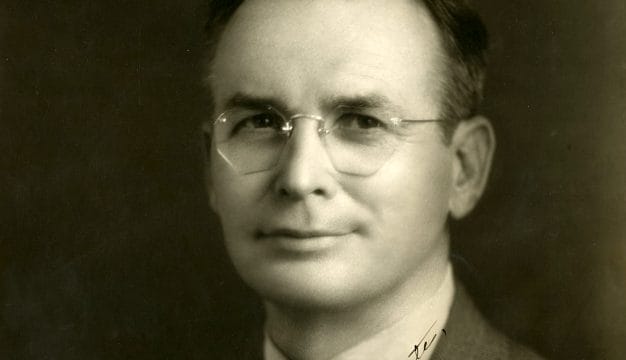Charlie Stripling
Charlie Stripling (1896-1966), a fiddler born in rural West Alabama in 1896, is esteemed by musicians and record collectors who specialize in southern old-time music. Stripling’s recordings have become classics and are included on many anthologies of recordings made between World Wars I and II, a period known as the “golden era of string band music.” His body of work has been released as “The Stripling Brothers: Complete Recorded Works—1928-1936” Document Records (1997).
 Charlie Stripling
Charlie Melvin Stripling was born August 8, 1896, in northeast Pickens County within a mile of the Fayette and Tuscaloosa County lines and about 12 miles from Kennedy in Lamar County, where he would eventually settle. His parents were Thomas Newton Stripling and Sarah E. Robertson, and he was one of eight children. As a teenager, he acquired a fiddle and learned his first pieces from a neighbor, Pleasant C. Carroll, known as “Uncle Plez,” who appears to be the source of the complex, archaic-sounding tunes for which Stripling is best known, such as “The Lost Child,” “Wolves A’Howling” and “Horseshoe Bend.”
Charlie Stripling
Charlie Melvin Stripling was born August 8, 1896, in northeast Pickens County within a mile of the Fayette and Tuscaloosa County lines and about 12 miles from Kennedy in Lamar County, where he would eventually settle. His parents were Thomas Newton Stripling and Sarah E. Robertson, and he was one of eight children. As a teenager, he acquired a fiddle and learned his first pieces from a neighbor, Pleasant C. Carroll, known as “Uncle Plez,” who appears to be the source of the complex, archaic-sounding tunes for which Stripling is best known, such as “The Lost Child,” “Wolves A’Howling” and “Horseshoe Bend.”
Ira Stripling, born in 1898, purchased a mail-order $6 guitar to accompany his brother’s fiddling and developed a strong, pulsing style that complemented it well. In a short time, the two began winning the numerous fiddlers’ conventions held in the area. These popular small-town events usually were organized to raise money for local schools, and prizes typically consisted of donated items such as sofa pillows, neckties, watermelons, and pigs. First-place winners, however, often won cash prizes ranging from $5 to $25. Such prize money became especially important to Stripling after he married Tellie Sullivan, age 14, in 1919, with whom he would have six children. A tenant farmer with little cash income, Stripling took these contests seriously and developed his skills to a degree that few in the area could match.
 The Stripling Brothers and the Freeman Brothers
The Stripling Brothers benefited from a change in the recording industry that occurred in 1923. That year Atlanta’s Fiddling John Carson had a hit recording with an old-time fiddle tune, and record companies saw the potential for rural customers. They began setting up temporary studios in cities such as Bristol, Tennessee; Jackson, Mississippi; Richmond, Virginia; and Birmingham, Jefferson County, and inviting fiddlers, string bands, Sacred Harp singers, and gospel groups across the states to audition.
The Stripling Brothers and the Freeman Brothers
The Stripling Brothers benefited from a change in the recording industry that occurred in 1923. That year Atlanta’s Fiddling John Carson had a hit recording with an old-time fiddle tune, and record companies saw the potential for rural customers. They began setting up temporary studios in cities such as Bristol, Tennessee; Jackson, Mississippi; Richmond, Virginia; and Birmingham, Jefferson County, and inviting fiddlers, string bands, Sacred Harp singers, and gospel groups across the states to audition.
In November 1928, the Brunswick-Balke-Collender Company set up a studio in the basement of the Bankhead Hotel in Birmingham, and citizens of Kennedy encouraged the Stripling brothers to audition. There they recorded two numbers, one being “The Lost Child,” which later was transformed into the popular bluegrass tune, “The Black Mountain Rag.” While in Birmingham, the Stripling brothers also played on radio station WAPI and soon began receiving invitations to play for dances in mining towns north and west of Birmingham. In addition to square dances, people also requested tunes for “toddles” and “foxtrots.” In response, Stripling created syncopated tunes he called “ragtime breakdowns” based on popular music of the day. Some of his well-known tunes, such as “Kennedy Rag” and “Coal Valley,” were driven by his need to keep up with the current dance trends.
In 1929, the Stripling brothers recorded 10 numbers at the company’s studio in Chicago. They recorded 14 more tunes in 1934 in New York City on the Decca label. That year Stripling’s wife Tellie died, leaving him with six children under 15 years old. He soon married Myrtle Wheeler, with whom he had three more children. The brothers had one more session with Decca in New Orleans in 1936 at which they recorded 14 more tunes. At this point, the Stripling Brothers duo came to an end because of economic difficulties caused by the Great Depression. Ira could no longer pay an employee to work in his store while he was away at performances. Also, few fans of country fiddling could afford to buy records during this period; thus, record companies dropped fiddlers and string bands from their roster of recording artists.
Charlie Stripling, however, continued to play for dances, school entertainments, and fiddlers’ conventions, accompanied by two of his sons, Robert Clifton and Lee Edwin Stripling. After the sons left home to fight in World War II, he put together a band that brought huge crowds to dances at National Guard armories in the area. His health began to fail at age 60, and he suffered stomach pains and arthritis that ended his playing career. He died January 19, 1966, and is buried near his birthplace in the cemetery of the Mt. Zion Primitive Baptist Church, which is also the resting place of his mentor, Plez Carroll (1850-1930).
In 1971, County Records reissued 13 of the Stripling Brothers’ original recordings as an album, bringing their music to a new generation of listeners worldwide. As a result, Charlie Stripling has come to be regarded as one of most important American old-time fiddlers. A recent article in the Old-Time Herald (April-May 2008) placed Stripling’s “Lost Child” at the top of a list of 100 “Essential Hillbilly Commercial Recordings on 78s.”
Additional Resources
Brierfield Ironworks. Possum Up a Gum Stump: Home, Commercial and Field Recordings of Alabama Fiddlers. Compact disc. Brierfield, Ala.: Alabama Traditions, 1988.
Cauthen, Joyce. With Fiddle and Well-Rosined Bow: A History of Old-Time Fiddling in Alabama. Tuscaloosa: University of Alabama Press, 1989.
Russell, Tony. Country Music Records, A Discography, 1921-1942. New York: Oxford University Press, 2004.
Stripling, Charlie, and Ira Stripling. The Stripling Brothers: Complete Recorded Works. 2 vols. Vienna, Austria: Document Records, 1997.



